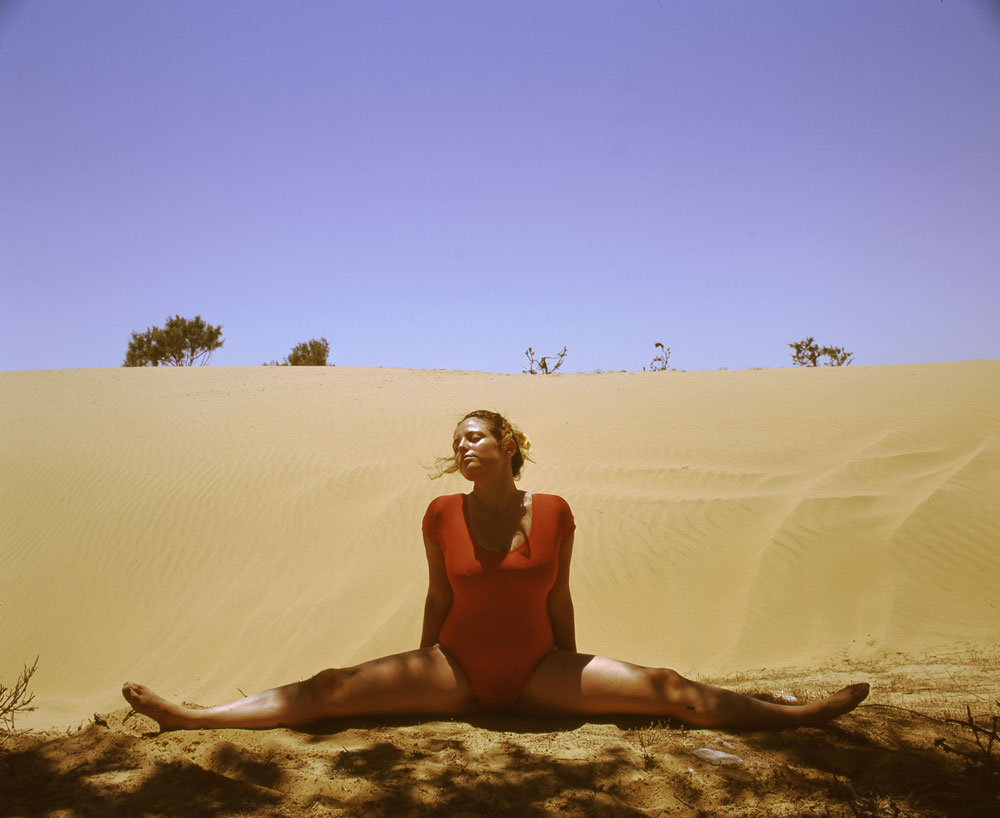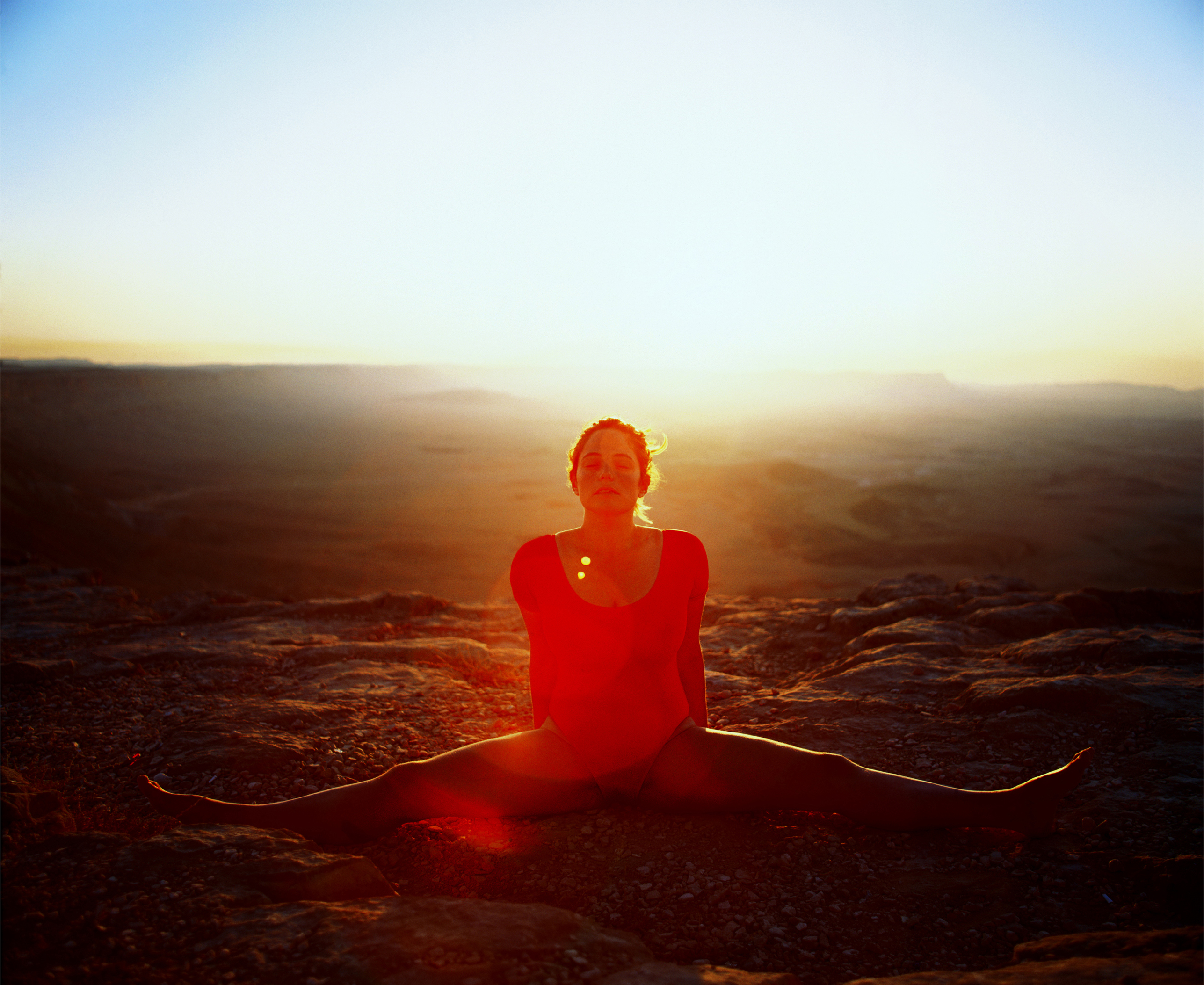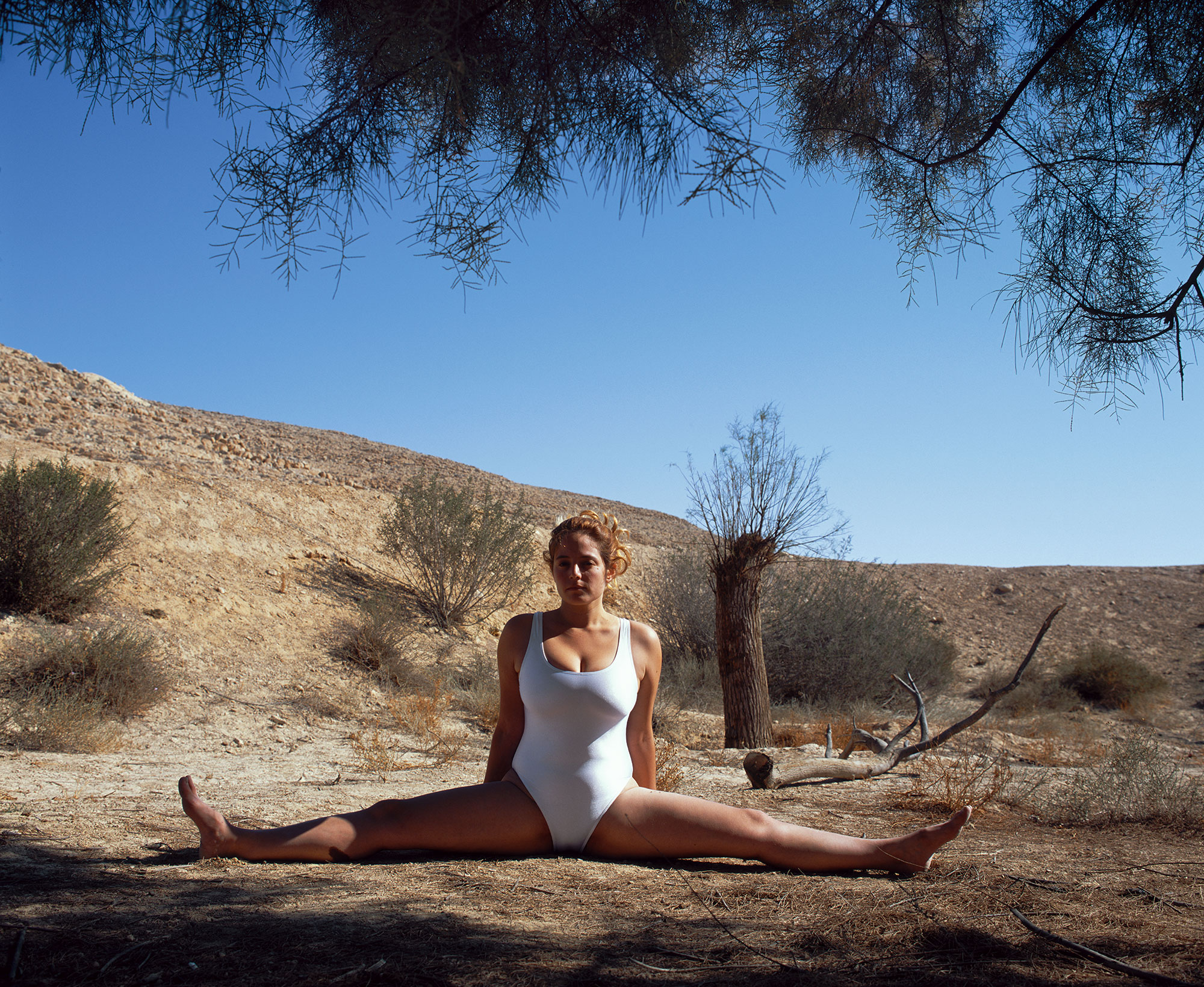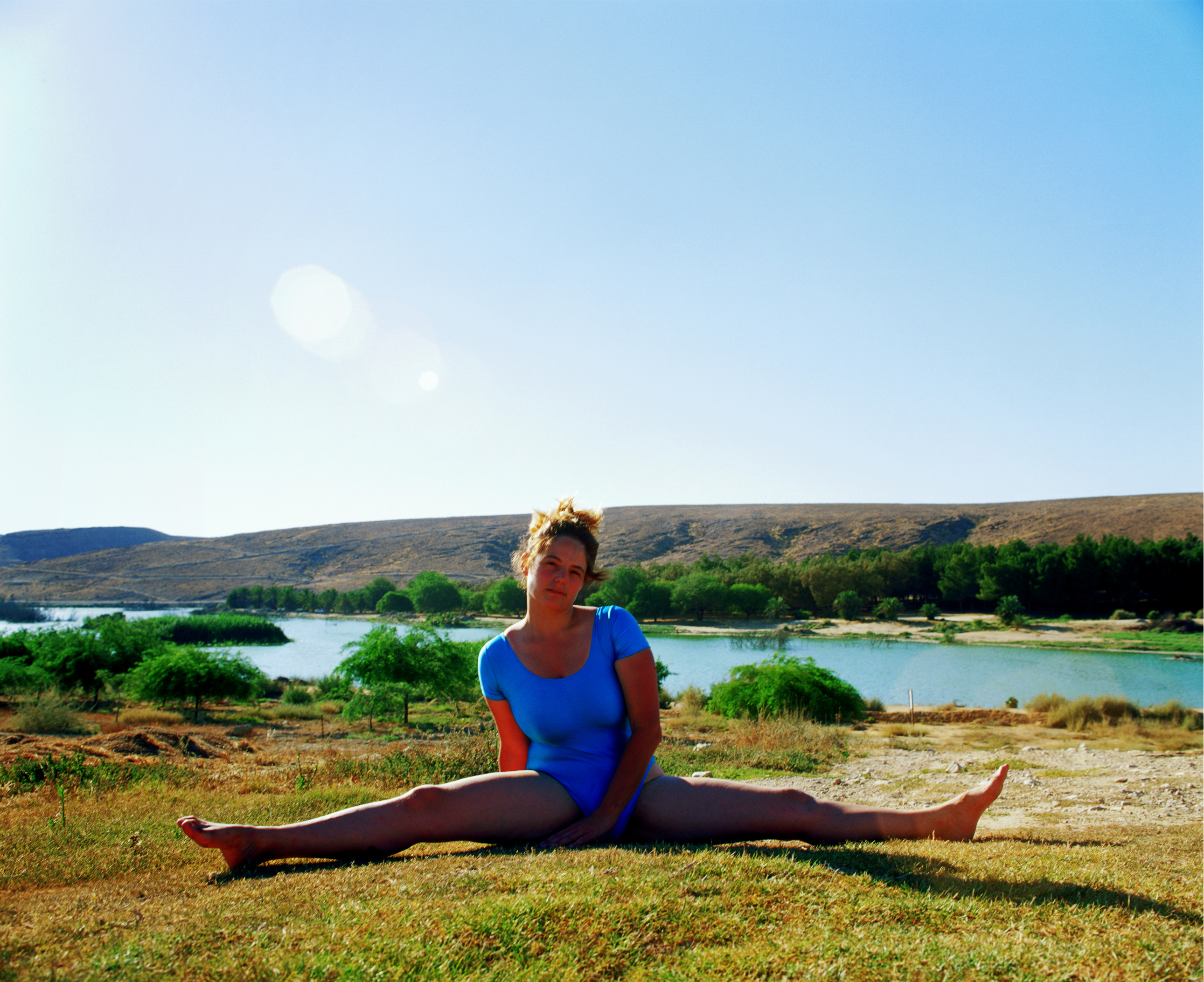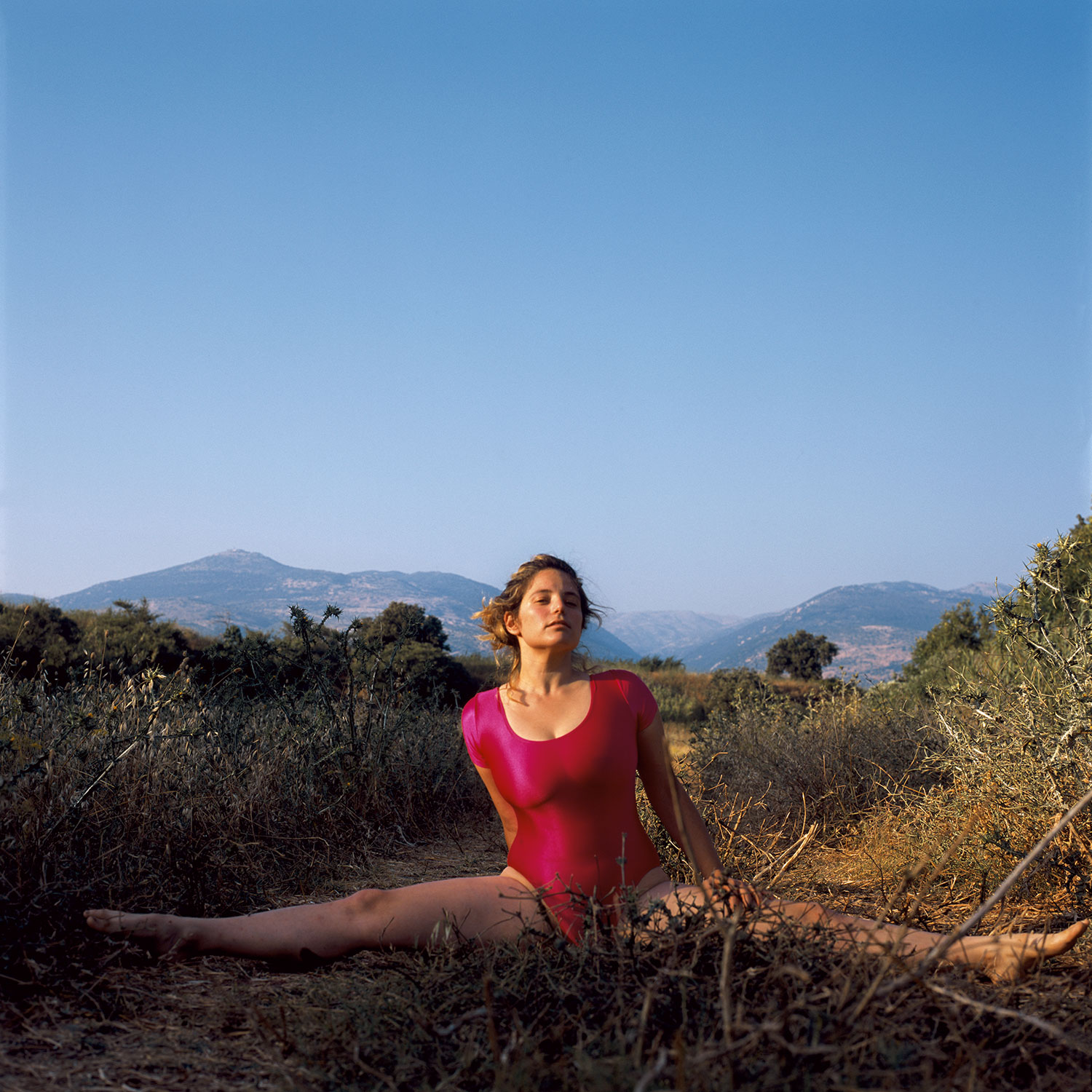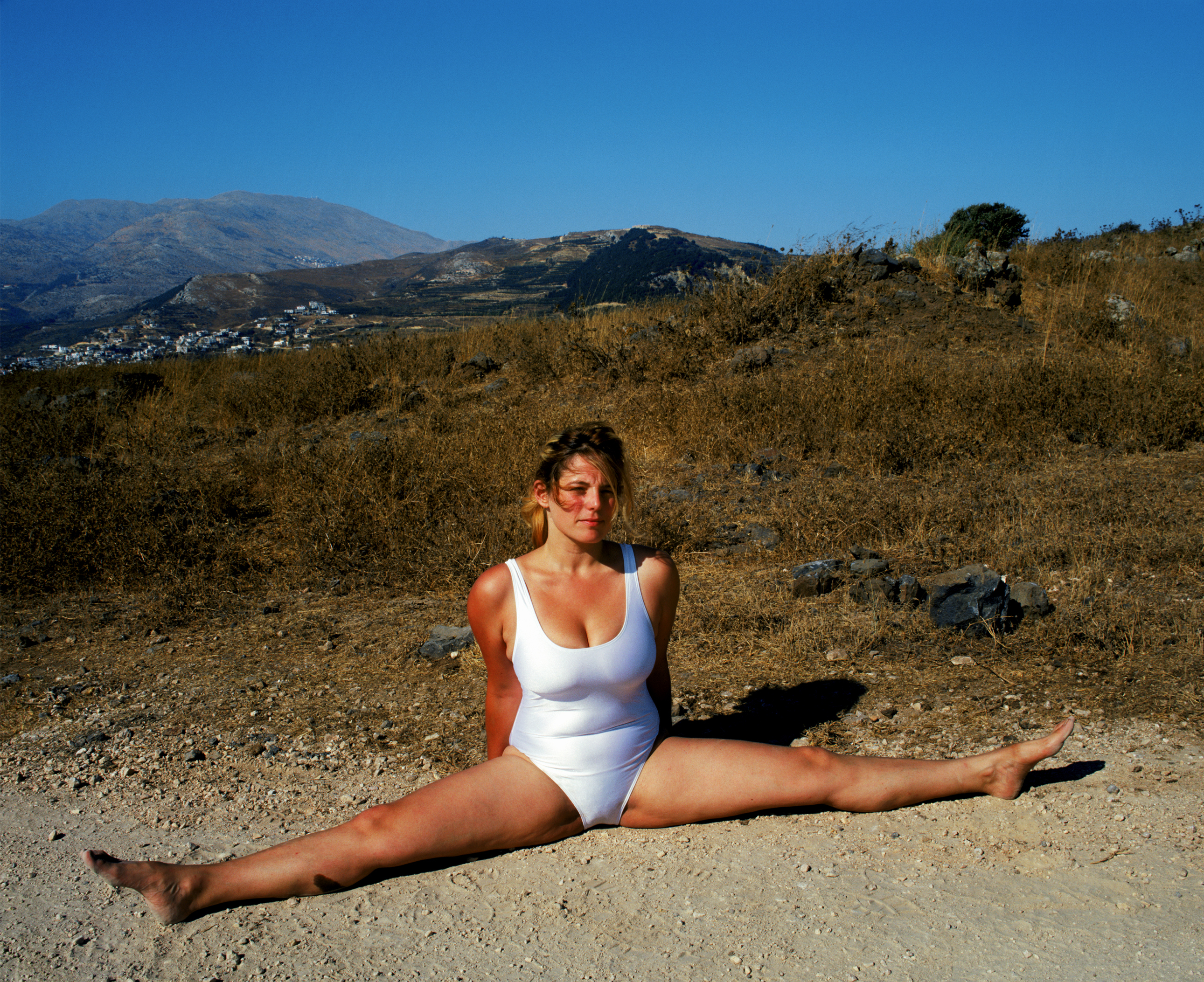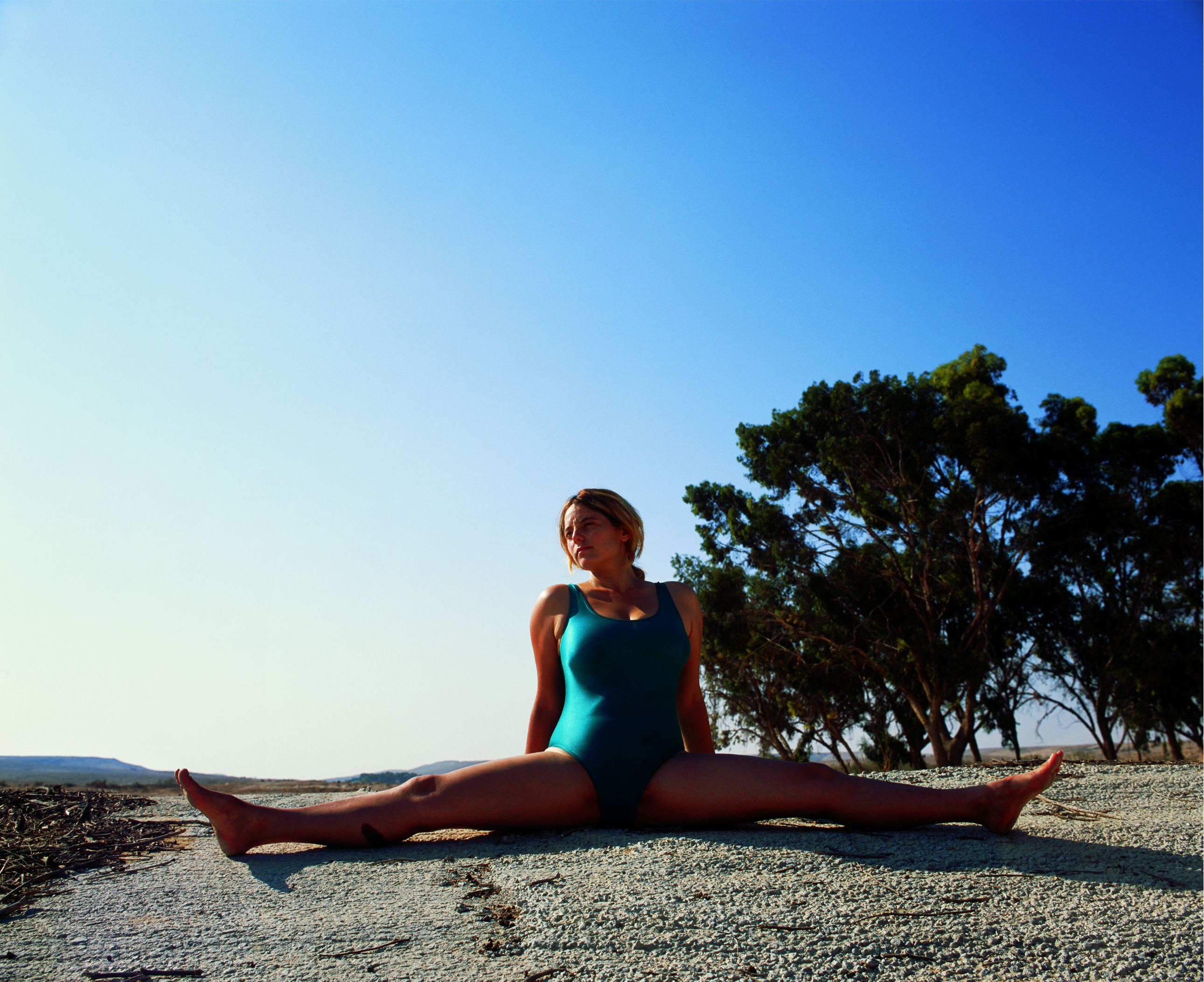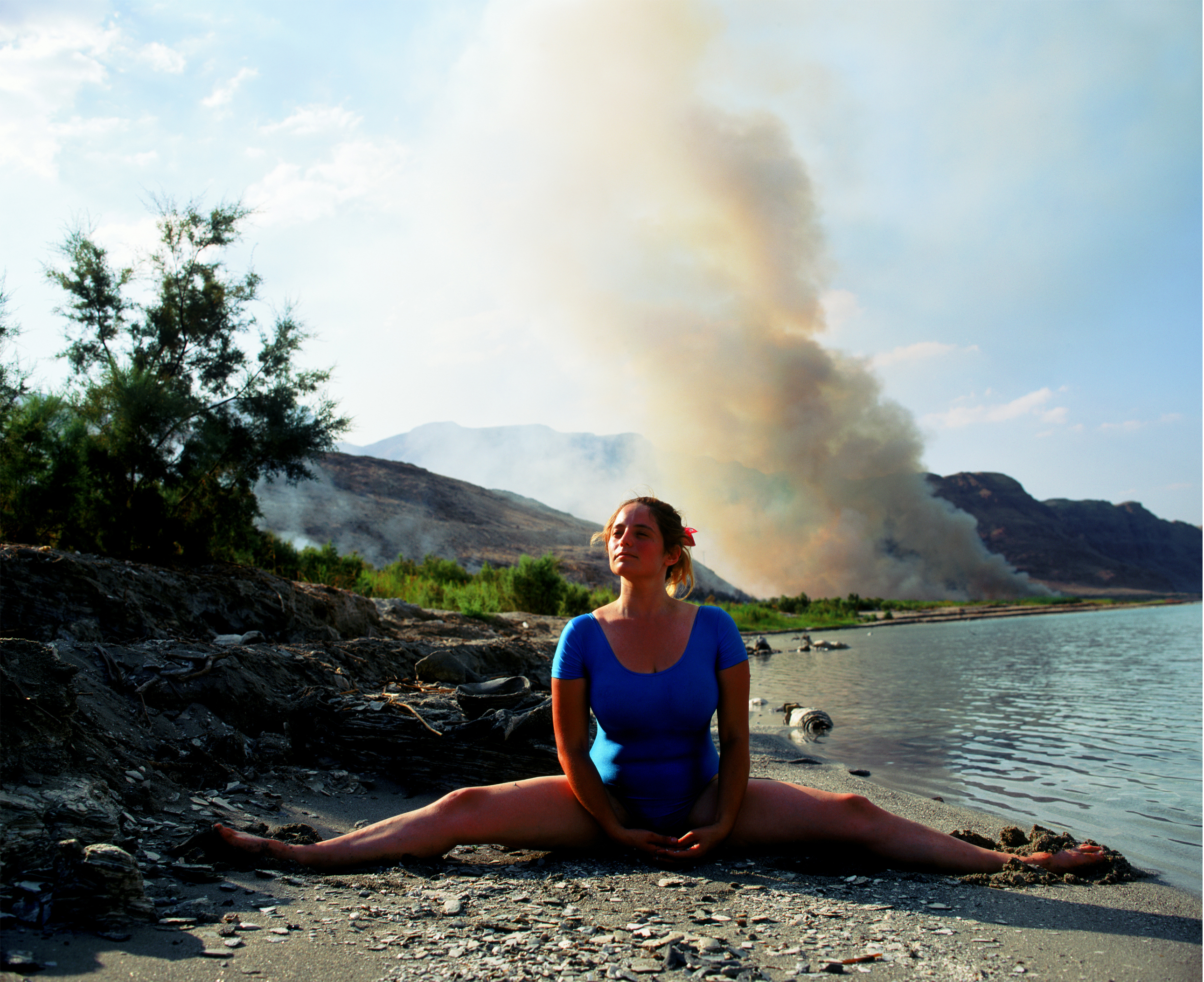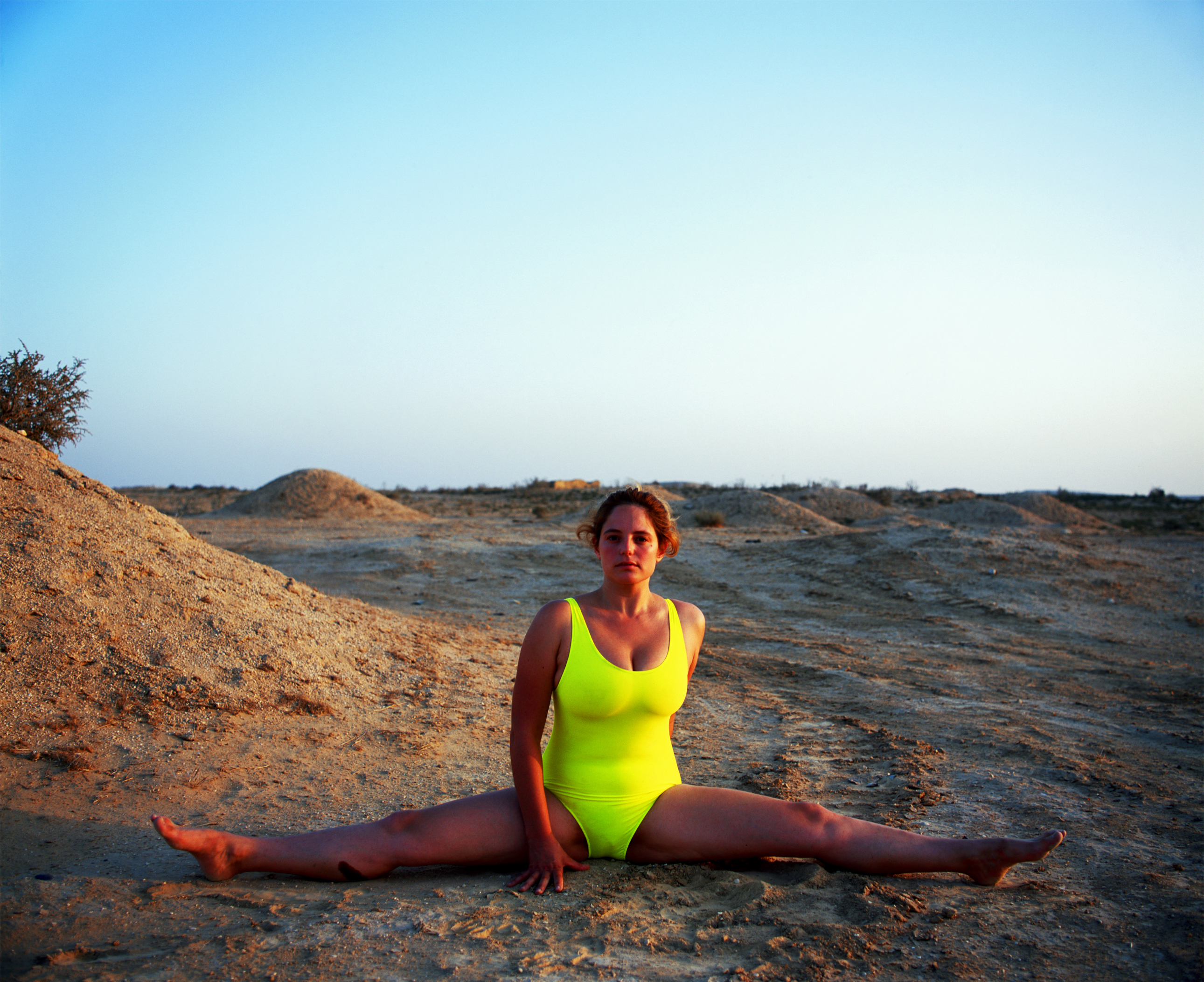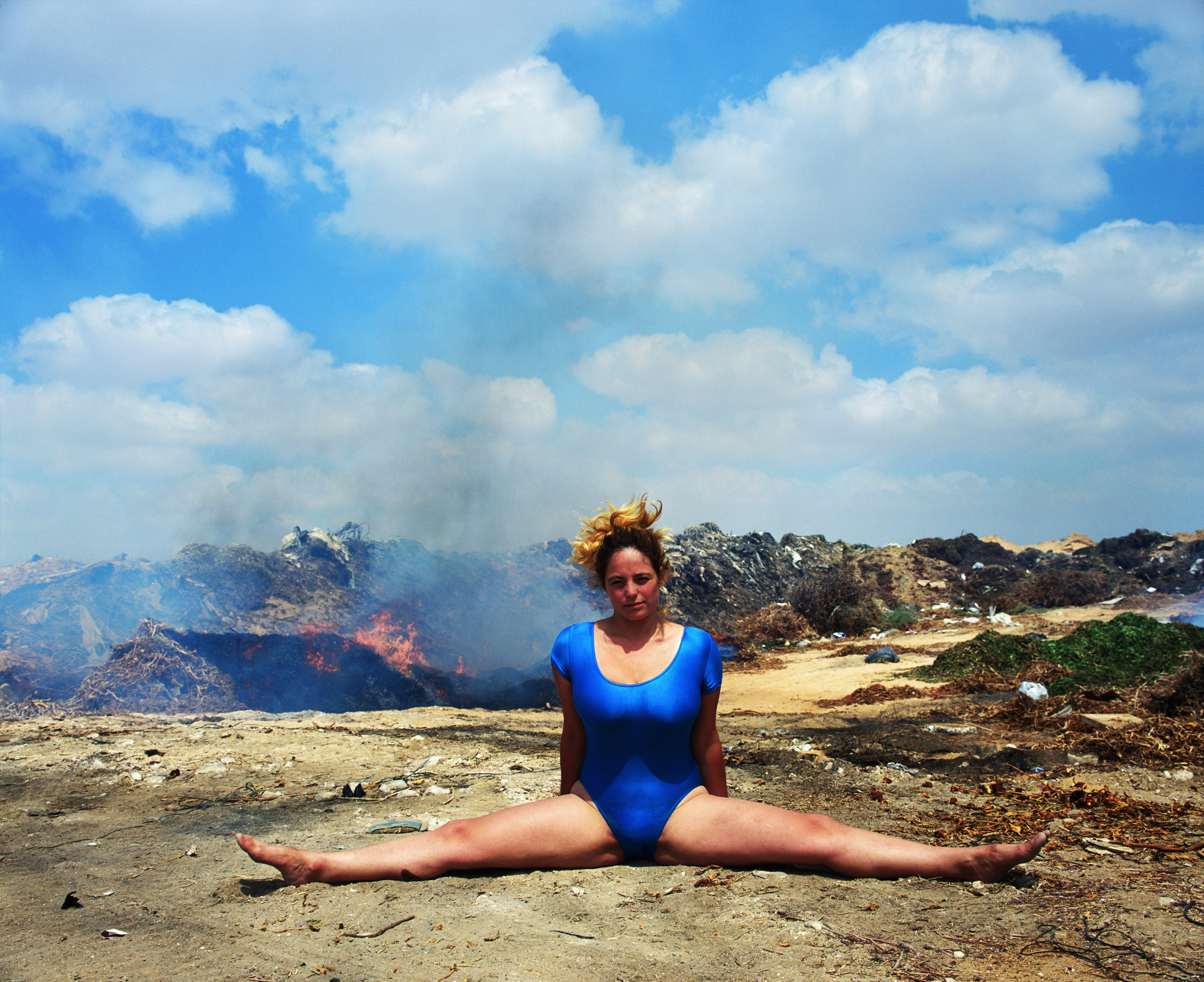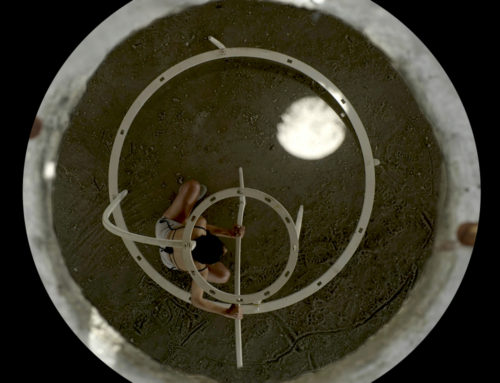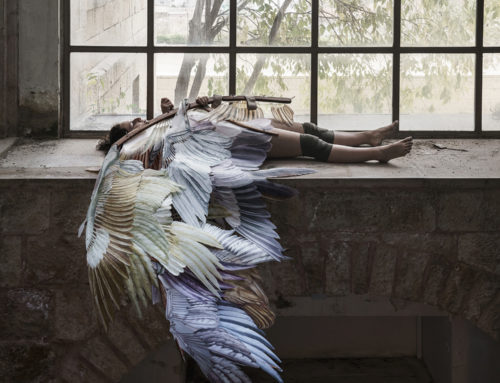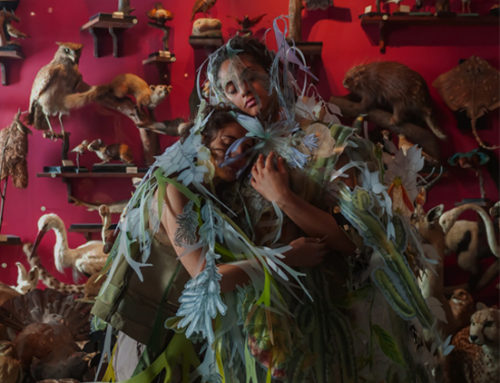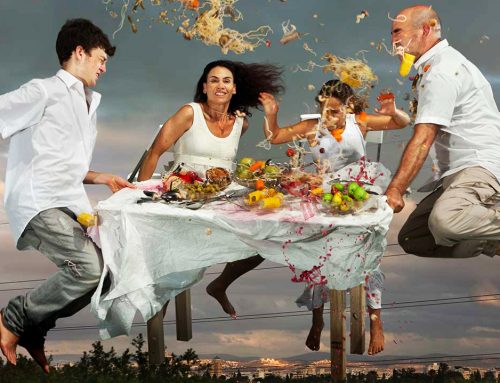SPLIT
Noga Gallery of Contemporary Art, June 2003
Gaze Body Earth / Hadas Maor
Meirav Heiman’s new series of photographs was taken over the past year at various places throughout Israel, especially in the Negev and the Jordan Valley. Shivtah, Ramon Crater, Yechiel Hills, Nachal Hed, Tze’elim, Urim, Nachal Chadav; unsettled areas with similar topographic characteristics such as areas of exposed earth, rocky hills, lone trees and different types of scrub. Yet despite the above, the fundamental deciding factor within the framework of the series is different, and is expressed through the repeated presence of a woman’s figure that appears in each and everyone of the photographs.
During her work on the series, Heiman traveled to different places throughout the country (1), placed the camera, set the frame, and positioned herself wearing a leotard in front of it, her legs spread wide facing the camera and her back to the open view.
Heiman’s decision to thus poistion herself in relation to the landscape creates a basic situation where she dominates the environment through the presence of her body, through her pose, and through the foreign colorfulness that she brings with her. But at the same time, the specific pose she has chosen places her in the landscape horizontally, spread out, present but also stuck. As it is not a simple position, and it does not allow any movement, it transforms her, to a point, from being an active subject dominating the landscape into a passive object located in it.
And thus, more than Heiman casts her gaze and photographs over the landscape, she turns her gaze directly toward the camera and photographs herself. Her presence becomes a central element within the photographed frame, in terms of the composition as she traverses the frame, in terms of the strong coloring of her leotards, and many cases, because of her defiant gaze that insists on interaction with the spectator by delaying the option of passing his/her gaze onto observing the landscape itself.
Heiman’s work combines two or even three different disciplines of action. On the one hand, she works within the framework of one of the oldest photographic genres, the genre of photography documenting distant sites and/or unique places, by relying on the unique characteristics of the photographic medium that Roland Barthes so adequately defined in the context of the concept “it was there” (or alternatively, “I was there” (2)). This photographic praxis possesses an obvious dimension of perpetuation and makes use of the photograph as witness.
However, if the sites or figures photographed in this framework, from the dawn of photography to this day, had a clear photographic and existential purpose (by being part of the lifestyle and culture of some place, or alternatively, by being external visitors who succeeded in getting there (3)), then Heiman’s presence in the frame of these photographed landscapes, at first glance, is indecipherable and puzzling.
On the other hand, her work does not settle comfortably into the photographic genre that places women in landscapes through reliance on familiar associative and archetypal connections, primarily the idea of connection between nature and femininity or the formal comparison between the topography and textures of landscapes and the physical forms of the female body.
The central reason for discomfort comes from the fact that Heiman combines contemporary notions linked to the praxis of staged self-photography. A photographic praxis that is linked to and demands taking a position in the public space and an autonomous positioning in the stratified sphere of the politics of identity.
In this regard it is interesting to note that the element of the spread-legs position, which appeared in Heiman’s early work, has been interpreted and given a clearer meaning in the framework of her present work – a meaning that breaks through the borders of the feminine/erotic/pornographic/gender discourse (4). Amongst other reasons, this meaning also springs from the essential difference between a standard spreading of the legs and the issue of physical ability to perform a split, as is appears in this series, for the split position is an achievement oriented act, that in its very nature asks to be recognized and valued not only in the cultural sense.
The parallel between the element of the physical stretch and the element of territorial conquest in the work connects to the dimension of alienation that Heiman’s presence creates in the landscape. This strengthens the dialectic sense of strangeness/belonging raised by the work.
Heiman – daughter of a rooted Zionist family, whose grandfather was one of the settlers of the 1940s and ’50s and was active in the Jewish Agency – deals in this series withthe problematics of her physical and ideological relations to concepts such as belonging, land, territory, and state, amongst other things; she pours into her photographic praxis a contemporary political dimension in both nationalist and gender terms.
***
There is no doubt that the preoccupation with local landscape, urban or natural, has become central to Israeli photography since the mid-nineties of the twentieth century (5). Most of the photography created in this context in the last few years has relied on the principles of typological photography, as formulated in the footsteps of and in relation to the German school of photography, and through a worldview that sees photography as a natural option for realizing analytical, reflexive, and discursive processes.
It can be said that the turning of the gaze to the local landscape has become a contemporary act, in some ways, even a characteristic one of building mutual relations with the local geographic, cultural, and ideological surroundings. Taken to an extreme, and it can be said that for those who grew up in Israel against the background of the Yom Kippur War, for those who matured and formed their adult identity in the presence of the Lebanon War, the Intifada and the Al-Aqsa Intifada, the action of operating a contemporary photographic gaze – adhering or critical – is an alternative and new option, perhaps the only one, that permits the questioning of place, of Israeliness and of identity without settling into a pre-constructed mode of nationalism; an option of constructing a relation with the place, but doing so without sanctifying it.
But it is specifically against the clear typological orientation of the local praxis that the unusualness of Heiman’s work stands out. Despite the fact that the series was photographed with a medium format camera, which permits, in principle, a potential for organizing the photographic field and achieving high-quality prints, yet it does not fit into the fundamental formalistic definition of typological landscape photography. In this way, for example, Heiman often places the camera opposite the sun, leaving areas in total shade, does not necessarily take care to line-up the perspective or sharpen the depth of field, etc.. While doing so, she provides an alternative to both the severity of the typological photographic gaze and to the imagined objectivity it is supposed to create.
And thus, the stratified dialectic formed through her work process touches photographic, political, and gender aspects simultaneously. Her work is saturated with sensuality but also with irony, with criticism, but also with childishness. She touches political charged and complex issues of conqueror/conquered, but does so without placing herself in any familiar dichotomy (man/woman, religious/secular, Jewish/Arab, etc.), to the point that it seems as if the dimension of extremity existing in her work permits her to emphasize these opposing aspects, to touch the perversion but also the absurd, and to build within them a harmonious, unique and strange situation.
Notes
(1) Meirav Heiman’s journeys to different photo sites were made in collaboration with Roi Kuper, friend and well-known artist, who helped her execute the photographs.
The issue of utilizing various professionals in the artistic framework, and even more so, the issue of possible collaboration between different artists, is in itself deserving of an extensive and in-depth discussion, but this is not the place to expand on it.
(2) Beyond stating the concept “it was there” Barthes expands and claims that the art of photography can never deny that the thing was there, and that the essence of the photograph was to confirm the existence of that which it represents. See Roland Barthes, Camera Lucida: Reflections of Photography (Noonday Press, 1982).
(3) For example, in Falu Zivlin’s work “Women in the Rishon Lezion Sand-Dunes”, c. 1927 or Elia Kahvedjian’s “By the Well”, 1935, and also Michal Heiman’s manipulation of existing photographs in the framework of her work “Michal Heiman Test (M.H.T.) No. 2”, 1998.
(4) In this context it is important to note work by artists such as Sarah Lucas (“Self Portrait with Skull”, 1997) or Tracey Emin (“I’ve Got it All”, 2000), for example, who made conscious and intended use of the spread-legs position directly in front of the camera lens in their works.
(5) During the second half of the 1980s the principle local photographic emphasis was on what was called at the time “personal photography” or “manipulated photography”, on the one hand, or magazine photography on the other. In both cases the praxis existed under the shadow of the struggle for the legitimization of the photographic medium in the wider artistic field. In contrast, in the second half of the 1990s, it is possible to identify the full-scale and definite return to direct photography in fashion, advertising, journalism, and in art.
